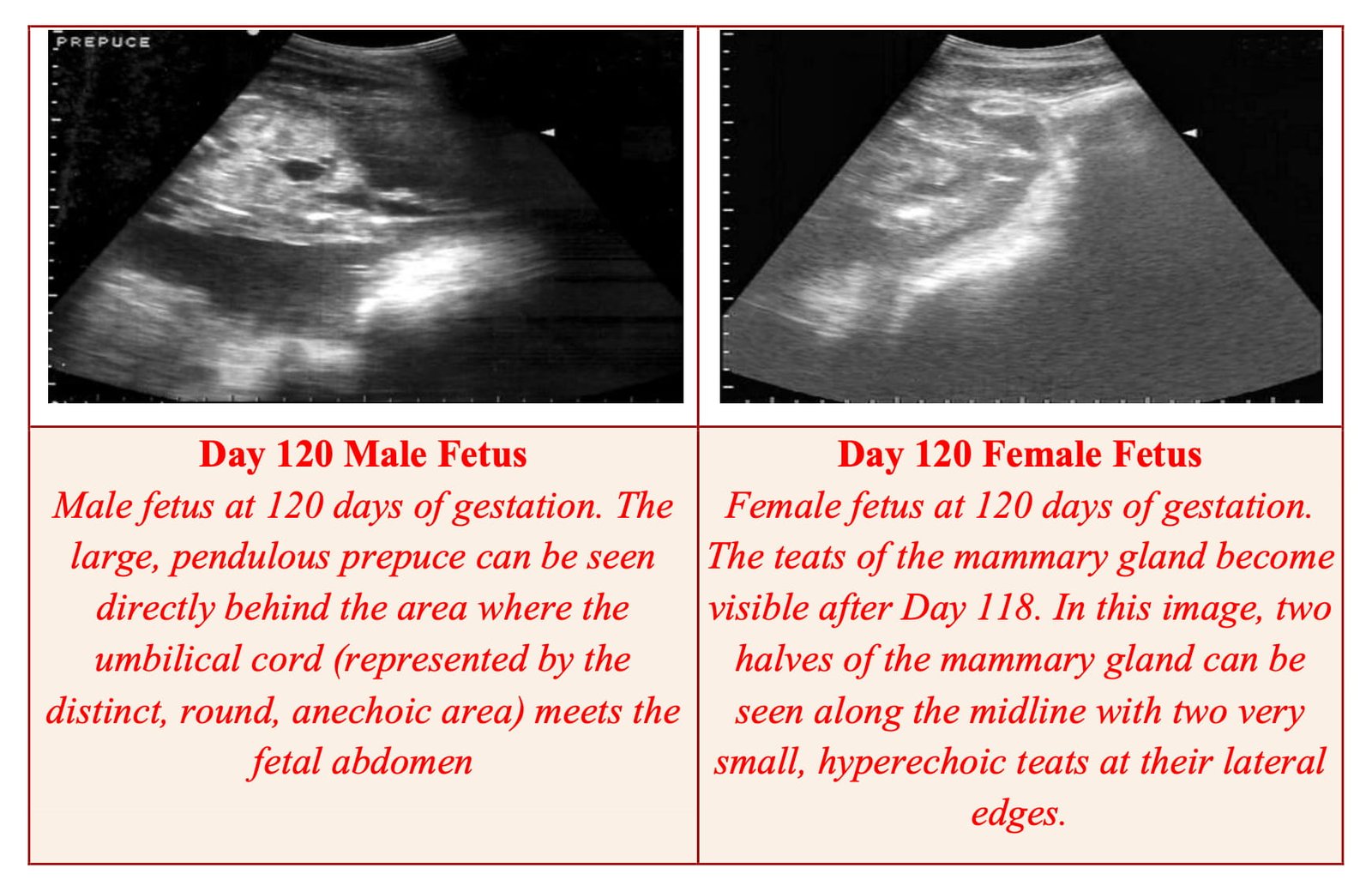TABLE OF CONTENTS
Pregnancy Diagnosis in Mares
Pregnancy diagnosis (cyesiognosis) in mares (female horses) are done by rectal palpation, Ultrasonography, laboratory methods, etc.
Signs of Pregnancy in Mares
A pregnant female hore show following signs:
- Failure of return to estrus is a good sign that a mare is pregnant.
- This requires the presence of a teaser stallion.
- It is preferable that mares should be accustomed to the teasing routine.
- Teasing should commence 16 days after service and continue for a further 6 days.
False positives will occur in following conditions:
- If the mare has a silent heat, a common problem when the foal is with mother
- If the mare becomes anoestrus as a result of lactation or environmental factors
- If the mare has a prolonged diestrus and yet has not conceived
- If the mare has a prolonged luteal phase associated with embryonic death; this is referred to as ‘pseudopregnancy’
False negatives will occur in following conditions:
- A few mares will show estrus although they are pregnant.
Rectal Palpation for Pregnancy Diagnosis
- Uterine tone is marked at 17-21 days of pregnancy when the cornua ? can be palpated as resilient tubular organs
- Palpation of the conceptus is first possible at 17-21 days when it is a small soft swelling of 2.4-2.8 cm.
- At about 100 days it is often possible to ballot the fetus as it floats in the fetal fluids of the uterine body
- Ovulation occurs commonly, 52-63 % in the left ovary, about 60% or more of the fetuses develop in the right horn
Based on the ovarian changes the gestation period may be divided in to 4 periods as follows:
- Period-I: (ovulation to 40 days) characterized by the presence of a single CL of pregnancy and a number of various sized follicles on both ovaries.
- Period-II: (40-150 days) characterized by marked ovarian activity with as many as 10-15 follicles (over 1 cm in diameter) and formation of 3-5 or more accessory corpora lutea in each ovary. This ovarian activity with follicle and corpora lutea formation is probably produced by the high level of gonadotrophic hormones secreted by the uterine endometrium from 40-120 days of gestation.
- Period-III: (150-210 days) characterized by regression of the corpora lutea or absence of follicles.
- Period-VI: (210 days to foaling) no corpora lutea or follicles are present.
During these latter two periods steroid hormones produced in the placenta maintain the gestation.


Ultrasonography for Pregnancy Diagnosis
In mares, three types of ultrasound are used for pregnancy diagnosis:
- Ultrasonic fetal pulse detector.
- Ultrasonic amplitude depth analyser (A-Mode).
- Brightness Mode (B-Mode) ultrasound.

Laboratory Methods
- Milk or Blood Progesterone
- Blood Estrogens
- Immunologic-Gel Diffusion or Haemagglutination-Inhibition Techniques
There are two biological tests methods performed for detecting pregnancy in mares:
- Ascheim-Zondek test.
- Mucin Test or Kursowa Method.
Chemical methods are used for detecting the presence of estrogenic hormone in the urine of pregnant mares. There are two tests:
- Cuboni’s Test
- Lunaa’s Test
Asheim-Zondek (AZ) Test
Asheim-Zondek (AZ) test used for detecting the presence of gonadotrophin hormones in the mare serum.
The gonadotrophic hormone from the endometrial cups is first found in the serum from 40-120 days of gestation, reaches its maximum between days 50-80, gradually declines and is absent after 150 days.
Materials Required
- About 10-20 ml of blood drawn from the jugular vein, after clotting and separation of serum at room temperature, the serum should be removed and refrigerated. Avoid overheating of the sample.
- One or preferably two or three immature female rats of 22 days of age.
Test Procedure
- Two ml of fresh blood or serum from the mare to be tested are injected intraperitoneally or 0.5 ml of serum can be injected s/c daily for 2-4 days.
- The animals are sacrificed 72 h later (when injected intraperitoneally) or 96-120 h later (when injected s/c).
Result
- In positive cases: Haemorrhagic spots or corpora haemorrhagica on the ovaries, edema of the uterine horns (2-4 times the normal size).
- In negative cases: No definite changes in the ovaries or uterus.
- False positive cases: May be due to over heating of the serum or storage for too long a period at room temperature.
Testing before 40 days and after 120 days of gestation may be inaccurate due to low level of circulating gonadotrophins in the blood.
Mucin Test or Kursowa Method
- A pregnancy test that utilizes changes in the cervical-vaginal mucus was developed by Japanese workers in the 1920‘s and 1930‘s.
- Applicable over a long period of pregnancy.
- The test is as follows:
- Spread a sample of mucin from the cervical os on to a glass slide.
- The mucous smear is fixed in alcohol, dried, and stained with methylene blue or hematoxylin.
Inference
- Smears from pregnant mares are thick and dark and contain globules of mucous and epithelial cells.
- Smears from non-pregnant mares are thin and pale and do not contain globules of mucous.
- Kurosawa method must be used with caution during the anestrous season. At that time the smears contain mucous globules, but differentiation can be made between anestrus and pregnancy by the absence of epithelial cells in the anestrus condition.
- The reliability of the test in pseudopregnancy has not been determined.
- False positives are likely.
Cuboni’s Test
- To 15 ml of urine add 3 ml of concentrated Hydrochloric acid in a 100 ml conical flask.
- Place in a boiling water bath for 10 minutes and cool under a tap.
- Add 18 ml of benzene with vigorous shaking for at least half a minute and the supernatant solution mainly the benzene is poured off.
- Then add 3-10 ml of concentrated sulfuric acid.
- Place in a boiling water bath at 80°C for 5 minutes and shake at intervals during this time. The mixture is then cooled.
Result
- Positive result: Presence of dark, oily green fluorescent colour in the lower layer of the sulfuric acid.
- Negative result: Absence of fluorescence and presence of brownish colour.
Accuracy of the test
- Highly accurate: 120-150 days or preferably 150-290 days of pregnancy.
- Not accurate: 75-120 days of pregnancy.
- After 250-290 days: Amount of urinary estrogens fall as end of gestation period approaches.
Lunaa’s Test
- Add 1 ml of urine to 10 ml of distilled water in 100 ml flask.
- Add 15 ml of concentrated sulfuric acid.
- After 3-5 minutes the flask is cooled.
- A strong, narrow, 3-5 mm flash light beam is placed close to the flask in a dark room.
- Positive: Presence of light green fluorescence.

